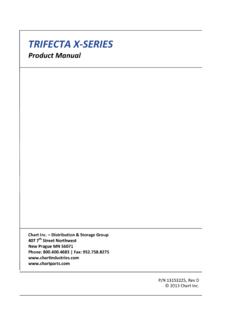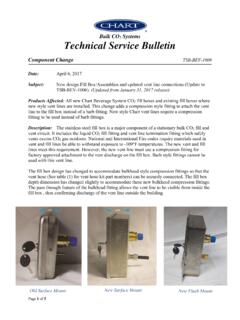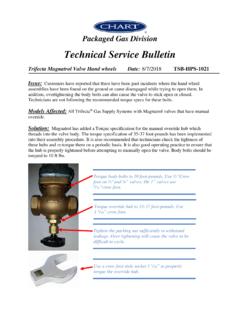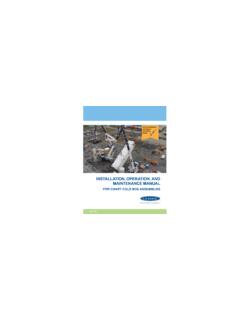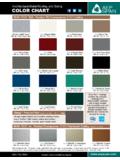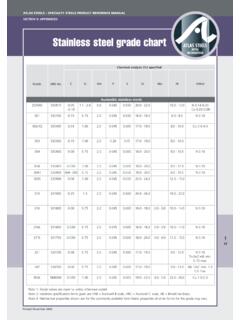Transcription of TheBasicsof AIR-COOLEDHEATEXCHANGERS - Chart …
1 The Basics of AIR-COOLED HEAT EXCHANGERS. HUDSON. Products Corporation A Subsidiary of Hudson Products Holdings, Inc. CONTENTS. Page FOREWORD ..i NOMENCLATURE ..ii I. DESCRIPTION OF AIR-COOLED HEAT EXCHANGERS ..1. Components ..1. Tube Bundle ..1. Axial Flow Fans ..5. Plenum ..6. Mechanical Equipment ..6. Structure ..6. Comparison of Induced and Forced Units ..7. Induced Draft ..7. Forced Draft ..7. II. THERMAL DESIGN ..8. Typical Heat Transfer Case I ..13. Application of Design Method ..19. Sample Problem ..20. Fan Selection Horsepower Requirements ..21. III. PERFORMANCE CONTROL OF ACHEs ..21. Varying Air Flow ..23. Extreme Case Controls ..23. Internal Recirculation ..23. External Recirculation ..23.
2 Co-current Flow ..23. Auxiliary Heating Coils Steam or Glycol ..23. IV. NOISE CONTROL ..24. V. DESIGN OF ACHEs FOR VISCOUS LIQUIDS ..24. VI. COST ..25. REFERENCES ..25. TABLES. Page 1. Guide to First Estimates of Bundle Rows ..19. 2. Typical Heat Transfer Coefficients for Air-Cooled Heat Exchangers ..19. FIGURES. Page 1. Typical Components of an Air-Cooled Heat Exchanger ..2. 2. Typical Construction of Tube Bundles with Plug and Cover Plate Headers ..3. 3. Fin Types ..4. 4. Header Types ..5. 5. Axial Flow Fan ..5. 6. Mechanical Components ..6. 7. Comparison of Induced and Forced Draft Units ..7. 8. Thermal Optimization Parameters ..8. 9. MTD Correction Factors, One Pass Cross Flow ..10. 10. MTD Correction Factors, Two Pass Cross Flow.
3 11. 11. MTD Correction Factors, Three Pass Cross Flow ..12. 12. Air Cooler Sizing Chart One Pass ..15. 13. Air Cooler Sizing Chart Two Pass ..16. 14. Air Cooler Sizing Chart Three Pass ..17. 15. Air Cooler Sizing Chart Four Pass ..18. 16. Unit Weight and Surface per Unit Fan HP as a Function of Bundle Depth ..22. 17. Air Flow Control ..23. 18. Unit Price as a Function of Total Surface and Bundle Depth ..26. FOREWARD. This brochure is designed to familiarize user with the types, components, and features of Air-Cooled Heat Exchangers (ACHEs) by means of simplified explanations and procedures. It discusses the advantages and disadvantages of each type of help designers become more discriminating, competent, and confident as users of this equipment.
4 The brochure also provides a method of estimating ACHE size, weight, price and power consumption in the planning stage, but is not intended to provide information sufficient for detailed and final design. If specific assistance is needed, please contact Hudson Products Corporation at (281) 275-8100. NOMENCLATURE. English Letter Symbols a = heat transfer surface area per unit length of tube ft2/ft A = total exchanger bare tube heat transfer surface ft2. Aw = average wall thickness in BWG = Birmingham wire gauge cp = specific heat Btu/(lb F). Cair = Ccold = Q / t = Q / (t2-t1) = air-side heat capacity rate Btu/(hr F). = FV L W. Ctube = Chot = Q / T = Q / (T1-T2) = tube-side heat capacity rate Btu/( hr F).
5 = Mcp Cmin = minimum heat capacity rate Btu/( hr F). Cmax = maximum heat capacity rate Btu/( hr F). CMTD = corrected mean temperature difference F. = F LMTD. E = exchanger thermal effectives Dimensionless = Chot (T1-T2). Cmin (T1-t1). = Ccold (t2-t1). Cmin (T1-t1). F = MTD correction factor Dimensionless f = Fanning friction factor Dimensionless i FA = face area ft2. FV = standard air face velocity std ft/min G = mass velocity lb/(sec ft2). h = individual heat transfer coefficient Btu/( hr ft2 F). ID = inside diameter of tube ft K = thermal conductivity Btu/( hr ft F). k = parameter, NTU or NTU R Dimensionless = n N a FV (I / U). L = tube length ft LE = calmed length ft LMTD = log mean temperature difference F.
6 M = mass flow rate lb/hr mw = minimum wall thickness in n = tubes per row, per foot of exchanger width l/ft N = rows of tubes in direction of air flow Dimensionless NRe = Reynolds Number Dimensionless Ntu = number of heat transfer units Dimensionless OD = outside diameter of tube ft P = number of tube-side passes Dimensionless Q = total exchanger heat load (duty) Btu/hr r = individual heat transfer resistance (hr ft2 F)/Btu R = Cmin / Cmax = heat capacity rate ratio Dimensionless S = specific gravity Dimensionless t = air temperature F. T = hot fluid temperature F. Tavg = bulk average temperature F. U = overall heat transfer coefficient (rate) Btu/( hr ft2 F). = 1. (ri + rair + rf + rm). W = width of exchanger ft Z = parameter, E or E R Dimensionless = T1 T2.
7 T1 t1. ii Greek Letter Symbols = viscosity centipoise = density lb/ft3. Subscripts air = air side max = maximum cold = cold fluid = air min = minimum f = tube-side fouling t = total hot = hot fluid = tube-side fluid 1 = inlet i = tube side 2 = outlet m = tube metal iii AIR COOLED HEAT EXCHANGERS A plenum between the bundle or bundles and the air-moving device. A proven means for cooling in the process A support structure high enough to allow air to and power industries enter beneath the ACHE at a reasonable rate. I. DESCRIPTION OF AIR-COOLED Optional header and fan maintenance walkways HEAT EXCHANGERS with ladders to grade. An ACHE is a device for rejecting heat from a fluid Optional louvers for process outlet temperature directly to ambient air.
8 This is in contrast to rejecting control. heat to water and then rejecting it to air, as with a shell and tube heat exchanger and a wet cooling Optional recirculation ducts and chambers for tower system. protection against freezing or solidification of high pour point fluids in cold weather. The obvious advantage of an ACHE is that it does not require water, which means that plants requiring large Optional variable pitch fan hub for temperature cooling capacities need not be located near a supply control and power savings. of cooling water. Tube Bundle An ACHE may be as small as an automobile radiator A tube bundle is an assembly of tubes, headers, side or large enough to reject the heat of turbine exhaust frames, and tube supports as shown in Figure 2.
9 Steam condensation from a 1,200 MW power plant . Usually the tube surface exposed to the passage of air which would require 42 modules, each 90 feet wide has extended surface in the form of fins to by 180 feet long and served by two 60-foot diameter compensate for the low heat transfer rate of air at fans driven by 500-horsepower motors. atmospheric pressure and at a low enough velocity for Components reasonable fan power consumption. An ACHE consists of the following components: The prime tube is usually round and of any metal suitable for the process, due consideration being given (See Figure 1): to corrosion, pressure, and temperature limitations. Fins are helical or plate type, and are usually of One or more bundles of heat transfer surface.
10 Aluminum for reasons of good thermal conductivity and economy of fabrication. Steel fins are used for An air-moving device, such as a fan, blower, very high temperature applications. or stack. Unless it is natural draft, a driver and power transmission to mechanically rotate the fan or blower. 1. Typical Components of an Air-Cooled Heat Exchanger Hudson Products Corporation Sugar Land, Texas, USA. Figure 1. 1. 2. 9. 3. 4. 5. 4. 6. 7. 8. INDUCED DRAFT. 6. 4. 5. 4. 3. 1. 2. 9. 7. FORCED DRAFT. 8. 1. Fan 4. Nozzle 7. Drive Assembly 2. Fan Ring 5. Header 8. Column Support 3. Plenum 6. Tube Bundle 9. Inlet Bell 2. Typical Construction of Tube Bundles with Plug and Cover Plate Headers Hudson Products Corporation Sugar Land, Texas, USA.
